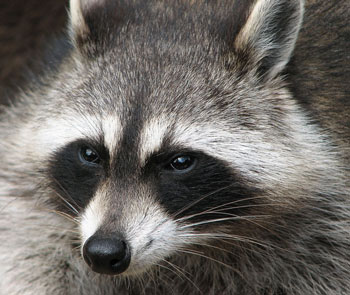Manage Your Garbage to Discourage Raccoons and Other Wildlife
By Chris Williams on September 15, 2014.
We just found out that we have a raccoon living in our crawlspace! We had seen it in our yard a few times but didn’t realize it had moved in. And we even have a dog, so I don’t know why it picked our house. T.T., Merrimack, NH
 Two probable reasons why that raccoon chose your house: (1) easy access into your crawlspace (vents without screens, a hole in a corner, a damaged access door, etc.) and (2) probably most importantly, easy access to food.
Two probable reasons why that raccoon chose your house: (1) easy access into your crawlspace (vents without screens, a hole in a corner, a damaged access door, etc.) and (2) probably most importantly, easy access to food.
If You Feed Them, They Will Come
Usually when I suggest that a customer is actually feeding the raccoons or opossums or skunks that are inhabiting their yard, they vehemently deny it. Then I point out the open garbage cans, or dog food dishes, or bird food under the feeder, the compost pile, or the rotting fruits or vegetables in the garden. These are all food for a wild animal, and food that is easy to access and is available all the time. What’s not to like if you’re a raccoon? If you can find cozy, covered shelter near that food source, even better.
Rethink Your Outside Garbage Storage
Garbage cans that are not animal-proof are usually the main draw for urban wildlife. The Centers for Disease Control (CDC) has supplied guidelines for homes and commercial sites for what it considers to be approved garbage (or recycling) storage. These are the requirements for rodent-proof containers, so you can image that these guidelines are the absolute minimum when you are talking about larger vertebrates like raccoons.
- Garbage containers have to be water-tight with tight-fitting lids, rust-resistant, structurally strong, easily filled, emptied, and cleaned. [Keeping raccoons out of a garbage can usually requires more than a tight-fitting lid. Bungee cords, special clamps, or a cinderblock on the top make it harder for that raccoon to get the lid off .]
- Galvanized metal or heavy, high-grade plastic containers qualify as long as they meet the other above criteria.
- Cardboard boxes are acceptable only for yard trash and nonfood items (metal, glass, carpeting, paper, cardboard, etc.).
- Plastic bags can be used alone for garbage only if they are properly tied and intact and are placed at the curb or alley for collection only on collection day and only during daylight hours. [Most wild animals are nocturnal foragers. Plastic bags left out at night will not survive intact if raccoons or other wildlife are around.]
Survey your yard for animal food sources and eliminate them. Maybe move garbage cans and pet dishes into the garage. Make needed repairs to keep animals out of your crawlspace. But first, contact a professional nuisance wildlife trapper to remove the raccoons so that they are not sealed into your crawlspace. At Colonial, our wildlife experts can humanely trap nuisance wildlife. We can also animal-proof your crawlspace and home, sealing and screening openings that animals could use to get inside. Give us a call!
For more on dealing with raccoons and other unwelcome wildlife, see these Colonial blogs:
- Why You Don’t Want Raccoons Around Your Property
- Keeping Raccoons Out of Your Garbage Cans
- Stop Providing Food for Local Wildlife
Photo credit: Foter / CC BY-SA
Sign up for our biweekly email newsletter for more information about bugs and pests!